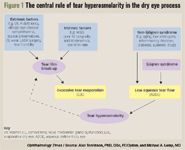Article
Dry eye disease: have we found the perfect diagnostic?
Tear hyperosmolarity is central to the dry eye disease process and the value of measuring tear osmolarity in the diagnosis of dry eye disease is well established. Alan Tomlinson, PhD, DSc, FCOptom, and Michael A. Lemp, MD, discuss the obstacles that physicians have come up against when attempting to diagnose dry eye effectively and accurately in a clinic setting. They also report on the latest research that has yielded some effective and user-friendly instruments, which now make osmolarity testing, and therefore, dry eye diagnosis, much easier.

Key Points
Editor's Note: This article appeared in the June 2008 edition of Ophthalmology Times Europe.
Dry eye disease usually is a symptomatic disorder that ranges in severity from mildly irritating to severely disabling. The main aim of diagnosis is to distinguish dry eye disease from other ocular surface diseases with similar symptoms, such as ocular allergy, surface toxicity, and chronic, low-grade infection. Tests also should be performed to establish the effect of the disease on a patient's quality of life and to quantify disease severity, to guide therapeutic choices.1 Its diagnosis, however, always has been difficult, especially in the early stages of the disease, because of the lack of availability of an agreed standard diagnostic test.
Tear hyperosmolarity is central to the dry eye disease process, and the value of measuring tear osmolarity in the diagnosis of dry eye disease is well established. Tear osmolarity measurement, however, has been restricted to research settings because conventional testing systems are complex, costly, time-consuming, or need larger tear samples than are obtainable in some forms of dry eye.
Are current tests good enough?
Current dry eye disease tests have several shortcomings. First, most tests look at physical endpoints or parameters that are signs of late-stage disease. This makes it difficult for eye-care practitioners to diagnose the majority of conditions definitively, because most patients have mild to moderate forms of the disease. Second, commonly used tests, such as the Schirmer test, ocular surface staining, and tear film break-up time, are only semi-quantitative, subjective, and have poor specificity. Third, existing tests are time-consuming and can be performed only by an experienced physician or technician.
Some eye-care practitioners use symptoms as the criteria for diagnosing dry eye. The administration of a structured questionnaire to patients certainly is a valuable tool for screening patients with dry eye disease.1 Symptoms alone are inadequate for the differential diagnosis of dry eye, however, because the same symptoms can be experienced with a range of ocular surface conditions and tear film disorders.2,3 In fact, the 2007 International Dry Eye Workshop (DEWS), in which we both participated, recommended that symptomatology questionnaires should be used in combination with objective clinical measures of dry eye status.1
The role of tear hyperosmolarity
The ocular surface requires a complete tear film to maintain its health and function, and this involves adequate production, retention, and balanced elimination of tears. Any imbalance of these components can lead to the condition of dry eye.
Many theories have been put forward to explain the mechanism(s) underlying the break up of the tear film. We considered these various theories during the DEWS meeting and concluded that tear hyperosmolarity is the central mechanism causing ocular surface inflammation, damage, and symptoms.1 Acknowledging that our understanding of the etiopathology of dry eye is rapidly advancing, current concepts relevant to tear hyperosmolarity can be summarized as follows:

Newsletter
Don’t miss out—get Ophthalmology Times updates on the latest clinical advancements and expert interviews, straight to your inbox.




